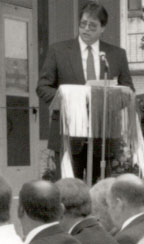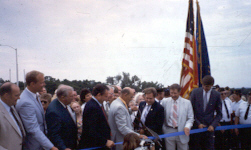

|
Aesthetic Protection Pioneers: |
|
THE LOWER WISCONSIN STATE RIVERWAY BOARD |
|
|
|
by Mark E. Cupp, Executive Director
Lower Wisconsin State Riverway Board |
|
|
|
"The Wisconsin River is very broad with a sandy bottom forming many shallows which render navigation difficult. It is full of vine clad islands. On the banks appear fertile lands diversified by woods, prairies and hills. We saw oak, walnut, basswood and another kind of tree armed with long thorns." Father Jacques Marquette (June - 1673)
Over three hundred years have passed since Father Marquette penned the first known written description of the Wisconsin River. Remarkably, in many places, the river has retained the same "look" viewed by the first European explorers and the countless generations of indigenous people before the famed voyage of Marquette and Joliet. The tremendous scenic quality of the lower Wisconsin River valley and the richness and diversity of the local flora and fauna provided the State of Wisconsin with an opportunity to create and implement a new and unique plan for protection and preservation of the valley’s natural and aesthetic resources. Enacted in 1989, the project, now known as the |

|
| Lower Wisconsin State Riverway, seeks to protect and preserve the scenic beauty and natural character of the river valley, seeks to manage the resources of the area for the long term benefit of the citizens of the state and seeks to provide a quality public recreational area in a manner consistent with the resource and aesthetic protection goals and objectives. The agency responsible for assuring scenic protection of the valley is the Lower Wisconsin State Riverway Board, a nine person citizen board with headquarters in Muscoda. |
"On the 8th of October, we put our canoes into the Wisconsin River which flows with a strong but smooth current. The water is very clear and through it you can see a fine and sandy bottom free of rocks. In the river are a few islands which are quite wooded. The land near the river seems to be excellent but, at a distance, is full of mountains said to abound in lead." Jonathan Carver (October - 1766)
Creation of the Riverway project was not an easy task. After years of planning and hundreds of hours of public meetings, a consensus had not been achieved. Many divergent opinions existed regarding the type of protection needed and the degree of regulation, if any, which should be involved. Eventually, a compromise was forged and the Riverway law was passed by the Legislature and signed by Governor Tommy G. Thompson in August of 1989. The new law detailed the major goals and objectives of the Riverway project and also created a new state agency, the Riverway Board, to administer the scenic protection regulations. The establishment of the Riverway Board was important to address concerns regarding retention of local control over the future destiny of the valley. As a result, the Riverway Board is dominated by local representation with six of the nine members coming from the affected counties (Dane, Sauk, Iowa, Grant, Richland and Crawford) and three members who represent recreational users and must reside outside of the Riverway counties.
The Riverway Board administers a system of regulations, known as "performance standards", which are designed to protect and preserve the aesthetic integrity of the valley. The regulations are not designed to prohibit development but, rather, to control land use and development to assure consistency with the objectives of the project. Permits are required for construction of new buildings, modification of existing structures, placement of mobile homes, construction of utility facilities as well as walkways or stairways which provide access to the river. Permits also are required for timber harvests conducted on the 80,000 acres within the project boundary.
"The Wisconsin River is a wide and shallow stream running over a bed of sand with transparent waters and chequered with numerous small islands and sand bars. It has an alluvial valley bounded by calcareous hills which frequently present naked precipices toward the river. The predominating trees are oak, elm and maple. The navigation of the river is considerably impeded by the sandbars and small islands and some time is lost is searching for the proper channel. The river bluffs continue, sometimes receding a mile or two from the river and giving place bottomlands and patches of prairie, then shutting in close upon the water’s edge." Henry Schoolcraft (August - 1820)
For new construction on lands visible from the river, compliance with the performance standards must be achieved in order to render the structure "visually inconspicuous" during leaf-on conditions. "Visually inconspicuous" is defined as "difficult to be seen or not readily noticeable" and does not mean the structure must be totally unseen when viewed from the river. The performance standards require screening vegetation between the structure and the river, the use of exterior colorization which harmonizes with the natural surroundings during leaf-on conditions (earth tones) and a limitation on the height of the structure. When building on a bluff, the slope of the site is limited to 20% or less and sufficient safeguards to prevent erosion must be utilized. To assist landowners, the board has developed a "Standardized Color Chart" which generally defines the parameters of acceptable exterior colorization. The palette of colors includes nearly fifty shades of greens, browns and grays.
For timber harvests on lands visible from the river, the regulations vary according to zone. In the area immediately adjacent to the river, the "River Edge Zone", only selective harvesting is allowed. On the hillsides visible from the river, the "Riverview Zone", selective harvesting is permitted and small clear cuts are allowed. On the tops of the bluffs, the "Bluff Zone", again, only selective harvesting is allowed. A minimum number of trees must be retained in the residual stand for all three zones and the location and design of logging roads also are restricted. Harvesting is limited to the late fall and winter months. Exceptions to the cutting regulations are provided for the removal of dead, damaged, diseased or insect infected trees or trees which represent a safety hazard. The timber harvest performance standards have been proven to mirror sound forestry management practices and provide ample flexibility for a variety of management practices to occur.
"The Wisconsin River valley is a wide, gloomy, mountain-girt valley, with great sandbars and thickly-wooded morasses. Settlement is slight. The few villages are generally a mile to three miles back, at the foot of the bluffs, out of the way of the flood, and the river appears to be but little used. None but a hermit could enjoy those long stretches of waterway where one may float for a day without seeing man or animal on the forest bound shores and where the oppression of solitude is felt with such force that it takes but slight stretch of the imagination to carry one’s self back in thought and feeling to the times when the black robed members of the Company of Jesus first penetrated the gloomy wilderness." Reuben Gold Thwaites (August - 1877)
|
The intent of the Riverway regulations to minimize the visual impact of an activity when viewed from the river during leaf-on conditions. The performance standards vary depending on the type of activity and visibility of the site from the river. For sites not visible from the river, the regulations are minimal. In the case of new structures or modification of existing structures not visible for the river, the sole restriction is on the height of the structure to assure it does not become visible from the river. For timber harvests on lands not visible from the river, a permit must be |
|
|
obtained to certify the harvest area is not visible from the river. While there are no restrictions on the harvest, recommendations are made to assure the harvest in conducted in a manner consistent with sound forestry management practices.
|
|

|
Administration of the Riverway regulations and protection of the resource is very much a cooperative endeavor. While the board is responsible for the scenic protection regulations, the Department of Natural Resources (DNR) is responsible for resource and recreational management issues and land acquisition. In the shoreland and floodplain zoned areas, each Riverway county administers local zoning ordinances which require minimum setbacks for buildings and limits on the amount of woody vegetation which may be removed. A partnership has been established between the board, the county zoning administrators and the DNR to assure the goals of the Riverway are achieved and the responsibilities of the respective jurisdictions are met. Much of the success of the Riverway is the result of the cooperation between these governmental entities. |
Ultimately, the success of the project rests on the cooperation of Riverway landowners. From inception, the biggest challenge facing the Riverway Board was to maintain the fragile and delicate balance between protection of the scenic beauty and natural character of the Riverway and protection of the rights of Riverway property owners and local residents. The concept of land use regulations for the purpose of preserving scenic quality is often difficult for landowners to understand. Some landowners consider the regulations onerous and unnecessarily restrictive and remain opposed to the Riverway concept. However, in the vast majority of cases, landowners and local residents have been cooperative and supportive. The Riverway Board works diligently to maintain a positive working relationship with landowners and attempts to minimize the impact of the regulations on the daily lives of Riverway residents. The board recognizes the importance of protecting the rights of property owners and local individuals and constantly seeks ways to achieve maximum protection of the resource with minimum regulation. The continued cooperation and support of landowners and local residents is the key to the success of the project.
"There are aspects of wilderness still, at its headwaters as well as near its mouth: in the wooded islands, the hill slopes, the forest country - and a kind of nostalgic wilderness in its: Wisconsin. Its waters, rising in a country of evergreens, birch, aspen, oak and ash, flow into the Father of Waters among honey locusts, chinquapin oak, black maple, and sycamores: once these were forests, reaching skyward, and they are only now beginning to come back - something starting over, something coming again, as if time were turning back to say that the prairie grass, the oak groves, the wilderness will return, not revenants of past time, but reality once more, to erase the marks remembered now, the ways the Indians went, and the trappers and the miners, the raftsmen and lumberjacks, the pioneers…" August Derleth (1942)
|

|
The Riverway law is indeed unique and innovative and is another example of the proud tradition of resource protection in Wisconsin. With the law in place, the people of Wisconsin are assured that the beauty and biological diversity of the river and its valley will remain for generations to come. With the continued sound stewardship of the land by private property owners, the effective and thoughtful management of the resource by the DNR and local authorities, and, with the scrupulous administration of the aesthetic protection regulations by the Riverway Board, the Lower Wisconsin State Riverway will remain one of the gleaming jewels in Wisconsin’s natural resources crown. |
"Yet there remains the river, in a few spots hardly changed since Paul Bunyan’s day; at early dawn…one can still hear it singing in the wilderness…Perhaps our grandsons, having never seen a river, will never miss the chance to set a canoe in singing waters." Aldo Leopold (1947)
For further information regarding the Lower Wisconsin State Riverway Board and the aesthetic protection regulations, contact Mark E. Cupp, Executive Director.


Last Modified: 5/5/2014 3:07:34 PM
|